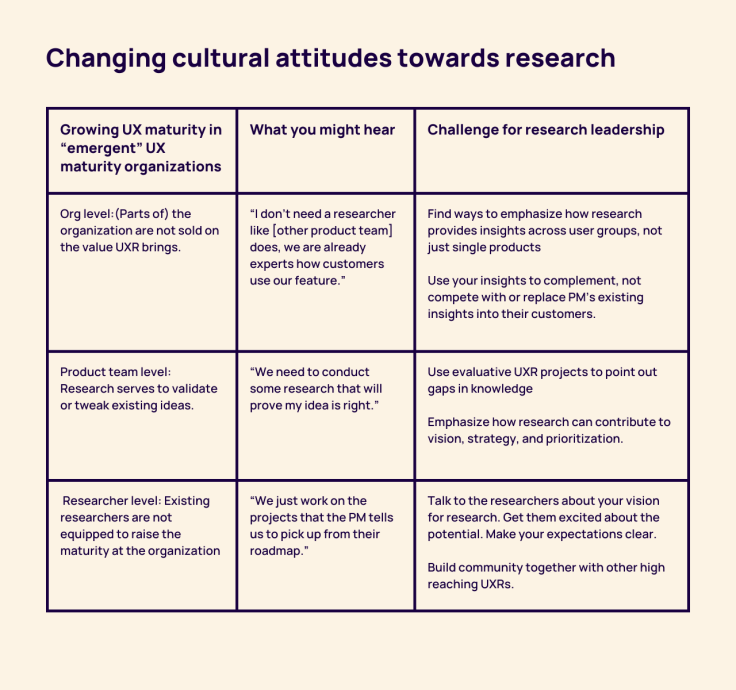How UXR leaders approach research in a low UX maturity organization

As user researchers, we’ve created a close-knit, supportive community around our craft. Scores of people are writing, speaking, and sharing regularly on topics of UXR best practice. That says something: our work is important to us. We want to find the most rigorous and compelling ways to share our insights with stakeholders, fellow researchers, and the rest of our organization.
But this drive toward excellence through best practices does not always reflect the reality of our workplaces. Striving for cutting edge research practice is difficult if your organization doesn’t even understand the fundamentals of research. This is often the case in organizations with low “UX maturity.“
There are ways to approach these challenges in the workplace. Before getting to specific examples, some definitions are in order. What is a “low maturity” organization? UX maturity is a bit of a buzzword, so let’s break it down.
The theory behind low UX maturity
In 2006, Jakob Nielsen created one of the earliest UX Maturity Models, called Corporate UX Maturity. Since then, Nielsen Norman has updated their model, naming six key stages on the road to a UX utopia, ranging from “absent” to “user-driven.” The argument goes that organizations proceed fairly universally through these stages. We can consider a low maturity organization as one that falls within the first three stages, somewhere between “absent” and “emergent.” (Note: Nielsen Norman’s UX Maturity Model is focused on UX in general, but in this article, I’m talking specifically about research challenges.)
The great news is that if you’ve been hired as a researcher, there is at least some level of buy-in for the work you are doing. Given your presence and your presumably busy workload, we could potentially classify your organization as at least “emergent”. Nielsen Norman says the emergent stage is when “a company’s UX efforts…are functional and promising, but inconsistent and inefficient.”
Let’s say your organization is far from utilizing the full potential of research expertise. If you work in a company like this, you’re probably nodding your head right now. (If you’re not sure, or you’d rather not just follow your intuition, there are clear ways to assess UX maturity. You can take a quiz following the Nielsen Norman approach, or take an approach we’ve outlined that’s specific to research efforts.)
A crucial part of assessing UX maturity is understanding how four key factors contribute to its development: strategy, culture, process, and outcomes. All of these factors need to be addressed to move an organization’s maturity forward. For the examples that follow, I focus primarily on culture, or a company’s knowledge about and attitudes toward UX. This is because culture shapes an organization’s approach and reaction to every piece of work you will do. It’s also often the most difficult to change, and the most ubiquitous to encounter in everyday work.
With this in mind, let’s take a look at some common scenarios that a UXR leader might encounter in an emergent UX maturity organization, particularly in relation to knowledge and attitudes toward research. We can break these examples down into key levels, namely, the organization level, the product team level, and the researcher level.

Growing UX maturity at the organizational level
Researchers can often find inconsistent reception for their work at the organizational level. One product team might embrace research insights, while another dismisses them. Product and company leadership hasn’t bought into research enough to steer or encourage a product-wide research practice, which leaves researchers in a challenging spot.
One way to solve this problem: rather than wholly focusing on individual products or product teams, communicate that research can bring its best insights when focusing on user groups, which are often relevant to multiple product teams (and even the whole organization).
This means potentially reexamining recent research projects and highlighting insights that are relevant for a user group rather than just a specific product. By sharing insights in this way, you can complement PM’s existing knowledge about their customers, and show them how your work can add to their existing insights, while simultaneously creating common ground across product teams.
Growing UX maturity at the product team level
Let’s say you’re working closely with a specific product team, and the PM sees research as providing its best work in validating just-launched features. To them, research provides insight into how a feature is received by the user or customer, and this insight can help them decide if and how to iterate on this feature.
This is indeed an offering that user researchers have in their vast toolbox. But your stakeholders are missing out if they see research contributing only to development and design validation. Sometimes insights shine the brightest and provide the most lasting impact when used in vision or strategy creation, and prioritization.
Are you stuck in a cycle of conducting usability tests, and feel discouraged that you’ll never get to dive into a strategic research project? Fear not! Usability tests can uncover insights into customer needs and behavior that you (and your stakeholders) weren’t expecting to see. Keep track of those bonus insights, and find an opportune time to share them. Don’t be afraid to suggest how they might be used to contribute to broader goals.
It could be that your stakeholder isn’t even aware, and your initiative could be the spark to change your work (and theirs!) for the better. Then, use this momentum to advocate for bringing research into the product development process earlier than the evaluation stage.
Growing UX maturity at the researcher level
Low UX maturity may be an issue at the organization or product team level, but it can also be an issue internally on your UX research team. Some researchers may simply be used to working in a low-maturity organization and don’t want to or don’t know how to push their craft forward.
This is arguably the most challenging aspect of growing maturity, as it stems from your own team. This is an issue that speaks to broader management challenges of inheriting research teams. Lead with positivity—show them what’s possible. Include your existing team when you create a vision and make sure to get everyone on board with your goals. Listen to your researchers and their challenges with key stakeholders. Coach them, and when necessary, step in and show them how to cheerfully challenge assumptions about research.
Finally, whether you’re tackling culture shifts at the organizational, product, or research level, get yourself a seat at the decision-making table. Changing organizational culture is a challenge. Making sure that leaders see and internalize the contribution research makes is the fastest path to growing the maturity of your organization.
Written by Janelle Ward, Principal Consultant, Janelle Ward Insights. Janelle has led UX research at digital product companies, both as a founding lead and as a manager upskilling and growing existing research teams. Janelle has a background in psychology and digital communication and spent a decade as an assistant professor before transitioning to UX research. She writes regularly about career and research topics. Outside of work, her life is a mix of parenting, partnering, reading great fiction (and trying to write it), caring for horses (not hers), and a dog and two cats (hers).
Get started for free
Log in or sign up
Get started for free
or
By clicking “Continue with Google / Email” you agree to our User Terms of Service and Privacy Policy


